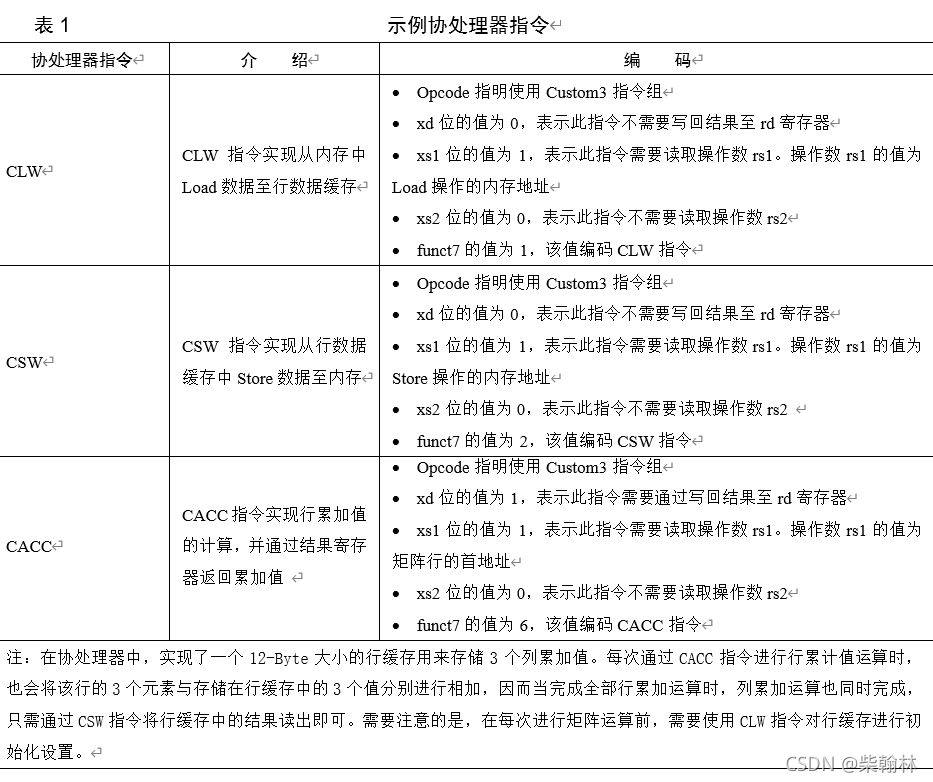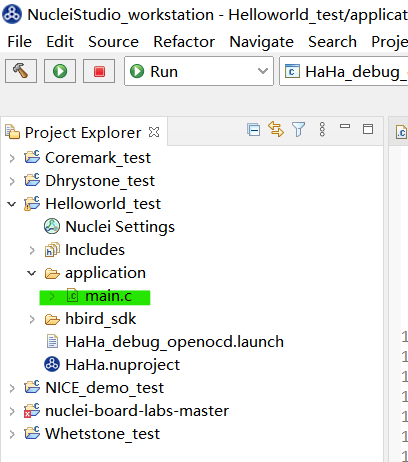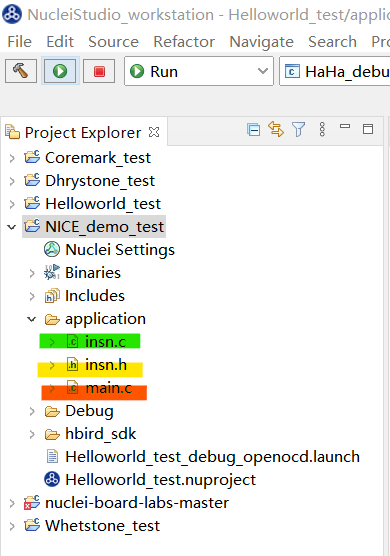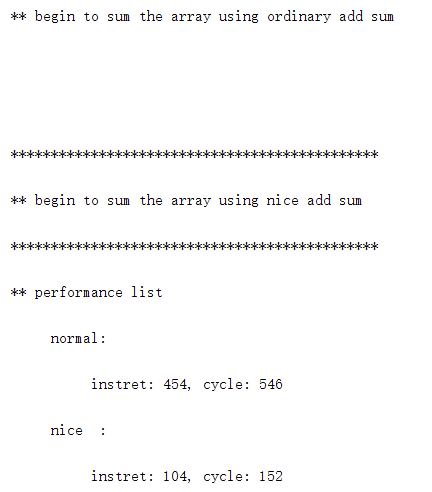团队编号:CICC1699
团队名称:到底叫啥队
赛题要求:
对蜂鸟E203 RISC-V内核进行运算算子(譬如加解密算法、浮点运算、矢量运算等)的扩展,可通过NICE协处理器接口进行添加,也可直接实现RISC-V指令子集(譬如P扩展、F/D扩展、V扩展、B扩展、K扩展等)
对于采用NICE协处理器接口进行的扩展实现,需要在蜂鸟软件开发平台HBird SDK中进行相关软件驱动的添加
实现思路:
参考示例:

硬件实现:(不太好写😭)
(e203_hbirdv2-master\e203_hbirdv2-master\rtl\e203\subsys\e203_subsys_nice_core.v)
NICE协处理器工作机理:👇

**NICE示例协处理器的设计:**
控制模块(和主处理器通过NICE协处理器的接口进行交互)+累加器(累加运算)👆
**NICE示例协处理器的自定义指令**👇

->verilog文件中包含内容:
自定义指令的编码+各模块功能实现(以状态机实现的转换)
软件驱动:
(nuclei-board-labs-master\nuclei-board-labs-master\e203_hbirdv2\common\demo_nice\insn.h)
基本格式:
.insn r opcode, func3, func7, rd, rs1, rs2
//.insn告知编译器当前的指令是.insn形式的指令
//r用来表示指令类型为R-type
//opcode、func3、func7、rd、rs1、rs2分别代表R类型指令格式的各位域
具体实现:(累加和)
// custom lbuf
__STATIC_FORCEINLINE void custom_lbuf(int addr)
{
int zero = 0;
asm volatile (
".insn r 0x7b, 2, 1, x0, %1, x0"
:"=r"(zero)
:"r"(addr)
);
}
// custom sbuf
__STATIC_FORCEINLINE void custom_sbuf(int addr)
{
int zero = 0;
asm volatile (
".insn r 0x7b, 2, 2, x0, %1, x0"
:"=r"(zero)
:"r"(addr)
);
}
// custom rowsum
__STATIC_FORCEINLINE int custom_rowsum(int addr)
{
int rowsum;
asm volatile (
".insn r 0x7b, 6, 6, %0, %1, x0"
:"=r"(rowsum)
:"r"(addr)
);
return rowsum;
}
测试程序:(nuclei-board-labs-master\nuclei-board-labs-master\e203_hbirdv2\common\demo_nice\insn.c —> 功能实现;nuclei-board-labs-master\nuclei-board-labs-master\e203_hbirdv2\common\demo_nice\main.c —> 顶层文件,测试输出)
/***********************************insn.c*********************************/
// normal_case:通过主流水线来实现的累加操作
int normal_case(unsigned int array[ROW_LEN][COL_LEN])
{
volatile unsigned char i=0, j=0;
volatile unsigned int col_sum[COL_LEN]={0};
volatile unsigned int row_sum[ROW_LEN]={0};
volatile unsigned int tmp=0;
for (i = 0; i < ROW_LEN; i++)
{
tmp = 0;
for (j = 0; j < COL_LEN; j++)
{
col_sum[j] += array[i][j];
tmp += array[i][j];
}
row_sum[i] = tmp;
}
}
// nice_case:调用NICE协处理器实现的累加操作
int nice_case(unsigned int array[ROW_LEN][COL_LEN])
{
volatile unsigned char i, j;
volatile unsigned int col_sum[COL_LEN]={0};
volatile unsigned int row_sum[ROW_LEN]={0};
volatile unsigned int init_buf[3]={0};
custom_lbuf((int)init_buf);
for (i = 0; i < ROW_LEN; i++)
{
row_sum[i] = custom_rowsum((int)array[i]);
}
custom_sbuf((int)col_sum);
}
/***********************************main.c*********************************/
// 主要就是调用两个函数然后输出结果
int main(void)
{
int i=100;
int arr[4]={1,2,3,4};
unsigned int array[ROW_LEN][COL_LEN]=
{{10,20,30},
{20,30,40},
{30,40,50}
};
unsigned int begin_instret, end_instret, instret_normal, instret_nice;
unsigned int begin_cycle, end_cycle, cycle_normal, cycle_nice;
printf("**********************************************\n");
printf("** begin to sum the array using ordinary add sum\n");
begin_instret = __get_rv_instret();
begin_cycle = __get_rv_cycle();
normal_case(array);
end_instret = __get_rv_instret();
end_cycle = __get_rv_cycle();
instret_normal = end_instret - begin_instret;
cycle_normal = end_cycle - begin_cycle;
printf("\n\n");
printf("**********************************************\n");
printf("** begin to sum the array using nice add sum\n");
begin_instret = __get_rv_instret();
begin_cycle = __get_rv_cycle();
nice_case(array);
end_instret = __get_rv_instret();
end_cycle = __get_rv_cycle();
instret_nice = end_instret - begin_instret;
cycle_nice = end_cycle - begin_cycle;
printf("**********************************************\n");
printf("** performance list \n");
printf("\t normal: \n");
printf("\t instret: %d, cycle: %d \n", instret_normal, cycle_normal);
printf("\t nice : \n");
printf("\t instret: %d, cycle: %d \n", instret_nice , cycle_nice );
printf("**********************************************\n\n");
printf("* * * * ***** * ******* *** \n");
printf("** * * * * * * * * \n");
printf("* * * * * * * * * \n");
printf("* * * * * * * ***** * \n");
printf("* * * * * * * * * \n");
printf("* ** * * * * * * * \n");
printf("* * ***** ***** ******* ******* *** \n");
printf("\n\n**********************************************");
return 0;
}
实际测试:

+ 将我们所编写的软件驱动文件和测试文件放入该目录下

+ 点击锤子🔨进行编译,做好硬件连接后,点击️️绿色的三角运行。
采用NICE协处理器进行的累加所用的指令数和周期数都远小于普通情况,如下图所示👇。

